

Édouard Vuillard : membre des Nabis. Les Nabis : post-impressionisme d' avant garde. Les Nabis (pronounced nah-BEE) were a group of Post-Impressionist avant-garde artists who set the pace for fine arts and graphic arts in France in the 1890s.

Initially a group of friends interested in contemporary art and literature, most of them studied at the private art school of Rodolphe Julian (Académie Julian) in Paris in the late 1880s. In 1890, they began to participate successfully in public exhibitions, while most of their artistic output remained in private hands or in the possession of the artists themselves. By 1896, the unity of the group had already begun to break: The Homage to Cézanne, painted by Maurice Denis in 1900, recollects memories of a time already gone, before even the term Nabis had been revealed to the public. Meanwhile, most members of the group—Maurice Denis, Pierre Bonnard, Édouard Vuillard—could stand, artistically, on their own. Origin of the term[edit] Homage to Cézanne, Maurice Denis, 1900. Nabi means prophet[1] in Hebrew and in Arabic. Egon Schiele : protégé de Klimt. Austrian painter Egon Schiele (German: [ˈʃiːlə] ( listen); 12 June 1890 – 31 October 1918) was an Austrian painter.
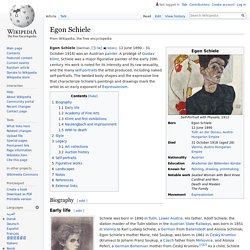
A protégé of Gustav Klimt, Schiele was a major figurative painter of the early 20th century. His work is noted for its intensity and its raw sexuality, and the many self-portraits the artist produced, including naked self-portraits. The twisted body shapes and the expressive line that characterize Schiele's paintings and drawings mark the artist as an early exponent of Expressionism. Gustav Klimt : Symbolisme. Early in his artistic career, he was a successful painter of architectural decorations in a conventional manner.
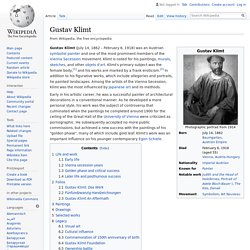
As he developed a more personal style, his work was the subject of controversy that culminated when the paintings he completed around 1900 for the ceiling of the Great Hall of the University of Vienna were criticized as pornographic. He subsequently accepted no more public commissions, but achieved a new success with the paintings of his "golden phase", many of which include gold leaf. Paul Cézanne : "Notre père à tous" (matisse et picasso)
Paul Cézanne (US /seɪˈzæn/ or UK /sᵻˈzæn/; French: [pɔl sezan]; 19 January 1839 – 22 October 1906) was a French artist and Post-Impressionist painter whose work laid the foundations of the transition from the 19th-century conception of artistic endeavour to a new and radically different world of art in the 20th century. Cézanne's often repetitive, exploratory brushstrokes are highly characteristic and clearly recognizable. He used planes of colour and small brushstrokes that build up to form complex fields. The paintings convey Cézanne's intense study of his subjects. Cézanne is said to have formed the bridge between late 19th-century Impressionism and the early 20th century's new line of artistic enquiry, Cubism. Both Matisse and Picasso are said to have remarked that Cézanne "is the father of us all. " Pierre Bonnard - Wikipedia. Pierre Bonnard (French: [bɔnaʁ]; 3 October 1867 — 23 January 1947) was a French painter and printmaker, as well as a founding member of the Post-Impressionist group of avant-garde painters Les Nabis.[1] Bonnard preferred to work from memory, using drawings as a reference, and his paintings are often characterized by a dreamlike quality.
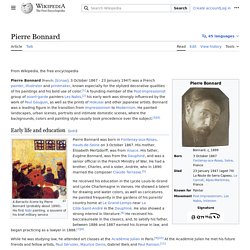
The intimate domestic scenes, for which he is perhaps best known, often include his wife Marthe de Meligny.[2] Early life[edit] Bonnard was born in Fontenay-aux-Roses, Hauts-de-Seine on 3 October 1867. He led a happy and carefree youth as the son of a prominent official of the French Ministry of War. He studied classics during his baccalaureate. Career[edit] In 1891, he met Toulouse-Lautrec and began showing his work at the annual exhibition of the Société des Artistes Indépendants.
Henri de Toulouse-Lautrec - Wikipedia. Early life[edit] After the death of his brother, Henri's parents separated and a nanny eventually took care of him.[4] At the age of eight, Henri went to live with his mother in Paris where he drew sketches and caricatures in his exercise workbooks.
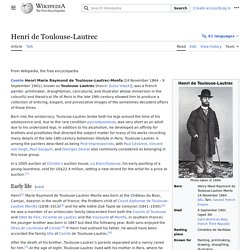
The family quickly realized that Henri's talents lay in drawing and painting. Symbolisme (art) Un article de Wikipédia, l'encyclopédie libre.
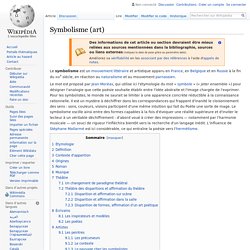
Des informations de cet article ou section devraient être mieux reliées aux sources mentionnées dans la bibliographie, sources ou liens externes (indiquez la date de pose grâce au paramètre date). Améliorez sa vérifiabilité en les associant par des références à l'aide d'appels de notes. Le mot est proposé par Jean Moréas, qui utilise ici l'étymologie du mot « symbole » (« jeter ensemble ») pour désigner l'analogie que cette poésie souhaite établir entre l'Idée abstraite et l'image chargée de l'exprimer.
Pour les symbolistes, le monde ne saurait se limiter à une apparence concrète réductible à la connaissance rationnelle. Il est un mystère à déchiffrer dans les correspondances qui frappent d'inanité le cloisonnement des sens : sons, couleurs, visions participent d'une même intuition qui fait du Poète une sorte de mage. Le symbolisme est une réaction au naturalisme. . « Car nous voulons la Nuance encore,Pas la Couleur, rien que la nuance ! Poésie. Gustave Moreau : précurseur du symbolisme. Edvard Munch. Paul Gauguin : Symbolisme. Eugène Henri Paul Gauguin (, ; French: [øʒɛn ɑ̃ʁi pɔl ɡoɡɛ̃]; 7 June 1848 – 8 May 1903) was a French post-Impressionist artist.
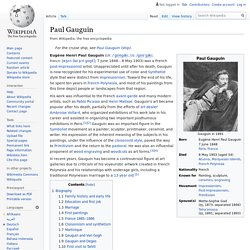
Unappreciated until after his death, Gauguin is now recognized for his experimental use of color and Synthetist style that were distinct from Impressionism. Toward the end of his life, he spent ten years in French Polynesia, and most of his paintings from this time depict people or landscapes from that region. In recent years, Gauguin has become a controversial figure at art galleries due to criticism of his voyeuristic artwork created in French Polynesia and his relationships with underage girls, including a traditional Polynesian marriage to a 13 year old.[5] Biography[edit] Family history and early life[edit] Gauguin's maternal grandmother, Flora Tristan (1803–1844) in 1838 Gauguin was born in Paris to Clovis Gauguin and Aline Chazal on June 7, 1848.
Education and first job[edit] James Ensor - Wikipedia. The Rower, 1883, oil on canvas, 79 x 99 cm, Koninklijk Museum voor Schone Kunsten, Antwerp Ensor in front of "Entry of Christ into Brussels" in his house in Ostend, 1940's, photo by Albert Lilar James Sidney Edouard, Baron Ensor (13 April 1860 – 19 November 1949) was a Belgian painter and printmaker, an important influence on expressionism and surrealism who lived in Ostend for almost his entire life.
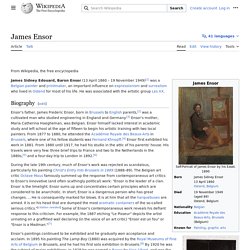
He was associated with the artistic group Les XX. Vincent van Gogh - Wikipedia. Dutch post-impressionist painter Vincent Willem van Gogh (Dutch: [ˈvɪnsənt ˈʋɪləm vɑŋ ˈɣɔx] ( Van Gogh suffered from psychotic episodes and delusions and though he worried about his mental stability, he often neglected his physical health, did not eat properly and drank heavily.